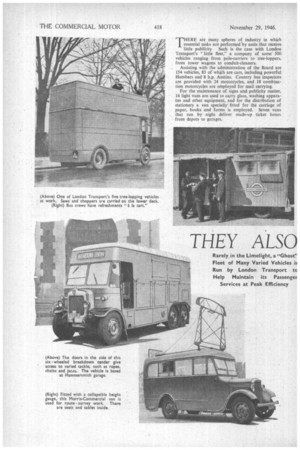THEY ALSO SERVE
Page 40

Page 41

If you've noticed an error in this article please click here to report it so we can fix it.
Rarely in the Limelight, a "Ghost" Fleet of Many Varied Vehicles is Run by London Transport to Help Maintain its Passenger Services at Peak Efficiency
THERE are many spheres of industry in which essential tasks are performed 'by units that receive lithe publicity Such is the case with London Transport's "little fleet," a company of some 500 vehicles ranging from pole-carriers to tree-toppers, from tower wagons to conduit-cleaners.
Assisting with the administration of the Board are 154 vehicles, 83 of whiph are cars, including powerful HuMbers and 8 hp. Austins. Country bus inspectors are provided with 24 motorcycles, and 18 combination motorcycles are employed for mail carrying.
For the maintenance of signs and publicity matter, 14 light vans are used to carry glass, washing apparatus and other equipment, and for the distribution of stationery a van specially fitted for the carriage of paper, books and forms is employed. Seven vans that run by night deliver made-up ticket boxes from depots to garages. Breakdowns on road and rail services are provided for by 21 vehicles of different types, including four A.E.C. sixwheeled 12-tonners.
When a London bus reaches retiring age, it is quite possible that it will spend the evening of its days as some old Ttype single-deckers are doing. Forty of these old-timers have had the tails of their chassis cut off and open truck bodies fitted. Rated as 7-tonners, these vehicles are used for stores-collection duties by various garages.
Often seen about the streets are the tower wagons, of width there are several types. The towers of these vehicles rise from about 15 ft. to 25 ft. All have a separate compartment for the crew when not working on the tower. A bell signal system operates between the tower platform and the driver's cab, so that by a code the driver can be instructed to raise or lower the tower and to move the vehicle.
Six tower wagons are conversions of NS buses—the first London doubledeckers to have an enclosed upper deck and introduced in 1925. Another six have been converted from Associated Daimler single-deck buses, whilst 22 are based on standard A.E.C. 5-ton chassis.
Keeping tram tracks in order is partly the job of nine Albions and nine .A.E.C.s. The Albions are 6-tonners, fitted with transverse gantries fore and aft to carry tram rails. An hydraulic crane operated by an engine-driven pump behint the cab is used for handling the rails.
Pole-carrying is the duty assigned to the A.E.C.s, which are 5-tonners. Their equipment is similar to that of the railcarriers, and the crane is used to drop tramway poles into holes, and to lift old poles out.
Arc-welding tram lines falls upon one of London Transport's welding lorries fitted with large generator plant, enabling repairs to be carried out on the spot. There are 15 of these lorries—six Albions, seven Leylands and two Karriers.
Also engaged on tram-track maintenance are two more converted T-type single-deckers and a steamer. These vehicles squirt water down the tramway third-rail conduit to clear it of dirt and rubbish. Water is carried in a large tank and a force-pump is used to flush the conduit.
Behind the trolleybus network are three vehicles which lubricate the overhead wires. Two are converted T types and the other an adapted Associated Daimler. They have special tiolley arms up which oil is fed to lubricate the wires. This oil is issued from London Transport's Chiswick laboratory and is stored in a large tank on the vehicle.
Even the gully-emptier is necessary
for the operation of London's passenger-transport services. London Transport has three of them—A.E.C.s with large cylindrical tanks and suction pumps. They clean drains and sumps at garages and depots.
Wherever there are railway extensions on the L.P.T.B. system, there is also likely to be one or more of 17 left-handdrive Canadian-built Ford tippers acquired from the Ministry of Transport.
Distilled water for batteries is distributed to depots and garages by a special lorry fitted. with a large tank. The tank is filled by the distiller and the lorry then delivers the water, thus effecting 'a saving of time over the method of delivery in carboys.
Cutting down nature when she stands in the path of progress falls to the lot of five of London Transport's vehicles. These are the tree-loppers. They go out on tour in the autumn, four to the
country and the other in the central London area, to cut back trees on routes covered by double-deck buses. In their hey-day these vehicles were ST buses. Now they have had their tops removed and their sides boarded up. The lower deck houses saws and choppers.
At the Chiswick works, and some other garages, shunting is carried on, but not by elderly, long-funnelled locomotives. Seven Fordson tractors, with solid rubber tyres and wood buffer blocks fore and aft are engaged on this fascinating work.
For route-survey duties there is a Morris-Commercial van fitted with seats and tables.
Chiswick and Acton works are supplied with fire-engines, and the Chiswick and Charlton works have their own ambulances.
Probably the most popular "little vehicles" are the dozen mobile canteens, which are placed at route termini for the benefit of drivers and conductors. Four have been made by converting ST buses and eight by adapting NS buses. They have cooking facilities on the lower deck and seats on top.
Also used in connection with the supply of food are 12 vans—Albions, Leylands and Fordsons—which distribute fresh meat and other foodstuffs to garage canteens. They have box bodies fitted with hooks and racks.
As a whole, the vehicles behind London's fleet of 9,200 motorbuses, trams, trolleybuses and . coaches present a highly varied collection. They show that motor vehicles can be adapted to perform almost any task, however odd, with efficiency and reliability.
























































































